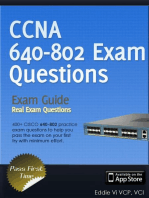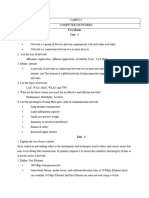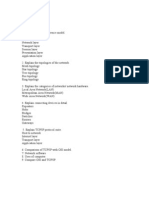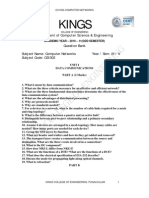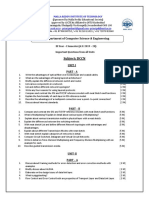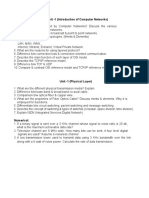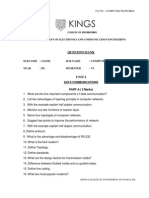Computer Networks
Uploaded by
priyaaramComputer Networks
Uploaded by
priyaaramUNIT-I
1. Explain the ISO-OSI model of computer network with a neat diagram.
2. Discuss the major functions performed by the Presentation layer and Application
layer of the ISO OSI model.
3. Explain Transport Layer and Physical Layer.
4. What are the major components of an optical communication system? Discuss.
5. Distinguish between point to point links and multi point links. Give relevant
diagrams.
6. Explain Data Link Layer and Network Layer.
7. Compare Connection oriented and connectionless service.
UNIT- II
1. a) What is the need for data encoding and explain the various data encoding
schemes and compare their features. (8)
b) Explain how hamming code can be used to correct burst errors. (8)
2. Explain the operation of the bit-oriented protocol HDLC with the required frames
3.Explain the various error detection and correction Mechanisms used in computer
network.
4. Write short notes on:
a) Go back NARQ (8)
b) Selective repeat ARQ (8)
5. a) Discuss the major functions performed by the Presentation layer and
Application layer of the ISO - OSI model. (8)
b) Compare Connection oriented and connectionless service. (4)
c) What are the major components of an optical communication system?
Discuss. (4)
6. a) A block of 32 bits has to be transmitted. Discuss how the thirty two bit
block is transmitted to the receiver using Longitudinal Redundancy Check.
(4)
b) Consider a 32 bit block of data 11100111 11011101 00111001 10101001
that has to be transmitted. If Longitudinal Redundancy Check is used what
is the transmitted bit stream?(4)
c) In the Hamming code, for a data unit of 'm' bits how do you compute the
number of redundant bits 'r' needed? (4)
d) What kinds of errors can Vertical Redundancy check determine? What
kinds of errors it cannot determine? (4)
7. Discuss stop and wait protocol
8. Discuss sliding window protocol using Go back n.
9. How does a Token Ring LAN operate? Discuss.
UNIT-III
1. Explain distance vector routing in detail.
2. Explain packet switching in detail.
3. What are routers? Explain in detail.
CS2302 Computer Networks
http://csetube.tk/
http://csetube.weebly.com/
4. What are the services provided by DNS server? Explain in detail.
5. Find the class of each IP address. Give suitable explanation. (8 x 2 = 16)
i) 227.12.14.87
ii) 193.14.56.22
iii) 14.23.120.8
iv) 252.5.15.111
v) 134.11.78.56
vi) 172.18.58.1
vii) 00000000 11110000 11111111 00110011
viii) 10000000 11110000 11111111 00110011
6. State the major difference between Distance Vector Routing and Link State
Routing. Discuss
how these routing techniques work.
7. What is the sub network address if the destination address is 200.45.34.56 and
the subnet mask
is 255.255.240.0?
8. List and diagrammatically illustrate and discuss the four general categories of
attack.
9. With relevant example discuss about Substitution Ciphers.
10. Briefly discuss how DES algorithm works.
UNIT-IV
1. a) Perform a comparative study between the ISO OSI model and the TCP/IP
reference model.(8)
b) Distinguish between point to point links and multi point links. Give
relevant diagrams. (8)
2. List and discuss the states used in the TCP connection management finite state
machine.
3. Discuss the various timers used by TCP to perform its various operations.
4. Present a tutorial on User Datagram Protocol (UDP).
5. Discuss the strategies TCP uses to avoid congestion.
6. Explain UDP & TCP.
7. Explain leaky bucket and token bucket algorithm.
8. Explain the duties of transport layer.
UNIT-V
1. Explain how security is provided in interact operations in detail.
2. What is HTTP protocol used for? What is the default port number of HTTP
protocol?
3. Discuss the features of HTTP and also discuss how HTTP works.
4. List and discuss the types of DNS records.
5. Explain WWW.
6. What are the duties of FTP protocol?
7. Explain the type of encryption/decryption method.
8. Explain about RSA algorithm
http://csetube.tk/
You might also like
- Lec. 17 18 Manual Part Programming, Formats. Code and Cycles - SINUMERIK System 810 T100% (1)Lec. 17 18 Manual Part Programming, Formats. Code and Cycles - SINUMERIK System 810 T23 pages
- Rhetorical Analysis - Our Vanishing NightNo ratings yetRhetorical Analysis - Our Vanishing Night4 pages
- Guides For Storage Tanks Nozzles Orientation100% (2)Guides For Storage Tanks Nozzles Orientation4 pages
- Kings: Department of Computer Science & EngineeringNo ratings yetKings: Department of Computer Science & Engineering5 pages
- Kings College of Engineering Department of Computer Science & Engineering Question Bank Subject: Computer Networks Year / Sem: III / VNo ratings yetKings College of Engineering Department of Computer Science & Engineering Question Bank Subject: Computer Networks Year / Sem: III / V4 pages
- COMPUTER NETWORKS unitwise important questionsNo ratings yetCOMPUTER NETWORKS unitwise important questions6 pages
- DCCN Important Questions From All Units Test-1 - 1No ratings yetDCCN Important Questions From All Units Test-1 - 14 pages
- Menu - 634642123980371250 - CS6107 Computer Networks TutorialNo ratings yetMenu - 634642123980371250 - CS6107 Computer Networks Tutorial2 pages
- Possible Question Summary From Previous Year QuestionNo ratings yetPossible Question Summary From Previous Year Question12 pages
- S.R.M. Institute of Science & Technology Department of Computer Science and EngineeringNo ratings yetS.R.M. Institute of Science & Technology Department of Computer Science and Engineering7 pages
- 18CSS202J - COMPUTER COMMUNICATIONS_4MARKSNo ratings yet18CSS202J - COMPUTER COMMUNICATIONS_4MARKS5 pages
- Unit - 1 (Introduction of Computer Networks)No ratings yetUnit - 1 (Introduction of Computer Networks)5 pages
- Sardar Raja College of Engineering, Raja Nagar, Alangulam: Department of Computer Applications Micro Lesson PlanNo ratings yetSardar Raja College of Engineering, Raja Nagar, Alangulam: Department of Computer Applications Micro Lesson Plan9 pages
- (Page No. 8) Activity: Chapter-1. The SentenceNo ratings yet(Page No. 8) Activity: Chapter-1. The Sentence20 pages
- System Software 2 Marks and 16 Marks With AnswerNo ratings yetSystem Software 2 Marks and 16 Marks With Answer23 pages
- Magic Mushrooms Change Brain Connections - Business InsiderNo ratings yetMagic Mushrooms Change Brain Connections - Business Insider4 pages
- Instant Access to Conflict Power and Organizational Change 1st Edition Deborah A Colwill ebook Full ChaptersNo ratings yetInstant Access to Conflict Power and Organizational Change 1st Edition Deborah A Colwill ebook Full Chapters40 pages
- J Institute Brewing - January February 1993 - Langstaff - The MOUTHFEEL of BEER A REVIEWNo ratings yetJ Institute Brewing - January February 1993 - Langstaff - The MOUTHFEEL of BEER A REVIEW7 pages
- Lec. 17 18 Manual Part Programming, Formats. Code and Cycles - SINUMERIK System 810 TLec. 17 18 Manual Part Programming, Formats. Code and Cycles - SINUMERIK System 810 T
- Kings: Department of Computer Science & EngineeringKings: Department of Computer Science & Engineering
- Kings College of Engineering Department of Computer Science & Engineering Question Bank Subject: Computer Networks Year / Sem: III / VKings College of Engineering Department of Computer Science & Engineering Question Bank Subject: Computer Networks Year / Sem: III / V
- DCCN Important Questions From All Units Test-1 - 1DCCN Important Questions From All Units Test-1 - 1
- Menu - 634642123980371250 - CS6107 Computer Networks TutorialMenu - 634642123980371250 - CS6107 Computer Networks Tutorial
- Possible Question Summary From Previous Year QuestionPossible Question Summary From Previous Year Question
- S.R.M. Institute of Science & Technology Department of Computer Science and EngineeringS.R.M. Institute of Science & Technology Department of Computer Science and Engineering
- Sardar Raja College of Engineering, Raja Nagar, Alangulam: Department of Computer Applications Micro Lesson PlanSardar Raja College of Engineering, Raja Nagar, Alangulam: Department of Computer Applications Micro Lesson Plan
- Internet of Things: Architectures, Protocols and StandardsFrom EverandInternet of Things: Architectures, Protocols and Standards
- CCNA Interview Questions You'll Most Likely Be AskedFrom EverandCCNA Interview Questions You'll Most Likely Be Asked
- Magic Mushrooms Change Brain Connections - Business InsiderMagic Mushrooms Change Brain Connections - Business Insider
- Instant Access to Conflict Power and Organizational Change 1st Edition Deborah A Colwill ebook Full ChaptersInstant Access to Conflict Power and Organizational Change 1st Edition Deborah A Colwill ebook Full Chapters
- J Institute Brewing - January February 1993 - Langstaff - The MOUTHFEEL of BEER A REVIEWJ Institute Brewing - January February 1993 - Langstaff - The MOUTHFEEL of BEER A REVIEW




